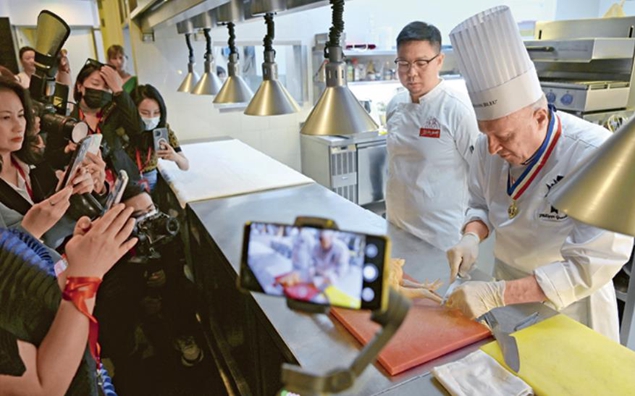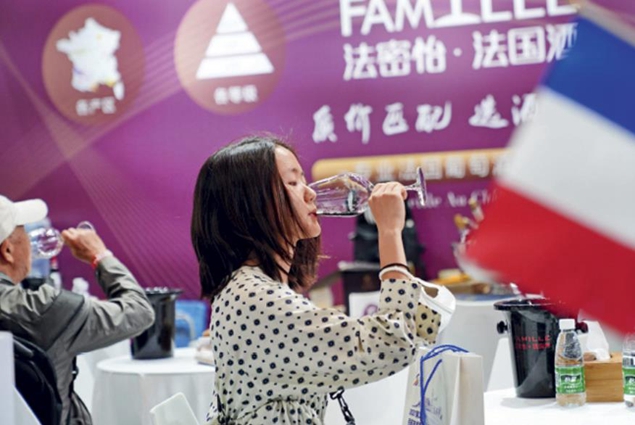China and France engage in in-depth cooperation in
the agricultural sector.
French gastronomy booth in the food and agricultural products area of the 6th China International Import Expo on November 8, 2023
At the end of June, the 4th edition of the “French House” event was held in Beijing. Organized by Hopscotch Season, it brought together 10 quality French brands to introduce the flavors of French gastronomy and share the French art of living.
In recent years, Sino-French cooperation in agricultural trade has intensified. Exchanges, especially in the import and export of grain, wine and dairy products, have continued to develop. In order to strengthen this partnership, governments and enterprises of both sides have signed agreements, deepened exchanges in agricultural science and personnel training, and made efforts to improve the quality and safety standards of agricultural products, aiming at win-win cooperation.
The charm of French gastronomy
France is China’s largest supplier of agricultural products to the EU. In 2023, China imported 46.95 billion yuan worth of French agricultural products, an increase of 50.5% over 2019. In the first quarter of this year, imports reached nearly 10 billion yuan. During French President Emmanuel Macron’s visit to China in April 2023, President Xi Jinping affirmed that China will promote its high-level opening-up to the outside world and share new opportunities brought by its development, expressing China’s willingness to build a rapid coordination mechanism with the French side along the entire chain called “from the French farm to the Chinese table”.
Over the past year, this mechanism has achieved remarkable progress. More and more French agricultural products are entering the Chinese market, bringing new opportunities to businesses and more profits to French farmers. Chinese consumers also have more diversified and high-quality choices and are discovering French gastronomy culture.
Take cheese as an example. Once a niche product in China, it is now one of the fastest-growing categories in the Chinese market. The awareness and acceptance of French cheese by Chinese consumers is due to the trade cooperation between the two countries, the development of dairy consumption in China and the active promotion of enterprises. French cheeses have won over the Chinese people with their unique taste, excellent nutritional value, diverse pairing possibilities and cultural richness. In Freshippo, a food retail company of Alibaba, 10 types of French cheeses are currently on sale, with sales more than doubling compared to the same period last year. Laurent Damiens, deputy general manager of the National Interprofessional Center for Dairy Economy (CNIEL), expressed his hope for the growth of the cheese market in China and his confidence in the future in an interview with CCTV.
In Sino-French cultural exchanges, cheese often plays the role of a “messenger”, building a bridge of understanding and friendship between the two peoples. These exchanges are not limited to tasting and appreciating food, but also encompassing respect and appreciation of cultures. “La Crèmerie” in Shanghai, the only dairy experience store in China certified by CNIEL, offers various activities such as cheese tasting classes and parent-child workshops. These initiatives allow Chinese consumers to experience the rich cheese culture and the unique charm of French cuisine and art de vivre.

Chef Philippe Groult (R), director of culinary arts at Le Cordon Bleu Shanghai, demonstrates the preparation of a French-style roast chicken, during the launch of the 6th edition of the Goût de France festival at the residence of the French Embassy in China in Beijing, October 8, 2021.
A sealed cooperation
Like cheese, wine is a key player in Sino-French exchanges. Chinese consumers’ interest in wine culture has increased compared to a decade ago, a trend driven by the rise of e-commerce and social media, bringing French wine closer to the Chinese public.
Today, the Chinese market offers a wide choice of French wines, whether red, white, rosé or sparkling. At the same time, the Chinese wine regions of Shandong, Ningxia and Xinjiang have matured in recent years. Local production and imports together contribute to the prosperity of the Chinese wine market.
At a similar latitude to Bordeaux, Ningxia is one of the most suitable regions for viticulture and fine wine production. Over the years, it has developed close ties with the Bordeaux region. In March 2021, the China-EU Agreement on Geographical Indications (GIs) came into force, and the wine appellation of the Eastern Helan Mountains Wine Region was included in the first list of China’s 100 GIs. In 2023, the International Conference on the Wine Industry was held in Ningxia, and Ningxia wines were introduced to the European market by U’Wine. From June 27 to 30, the Eastern Helan Mountains Wine Region was invited to participate in the Bordeaux Fête le Vin 2024 event, a first for a Chinese wine region.
In the Joint Declaration between France and China on Agricultural Exchanges and Cooperation issued in May, it was stressed that France supports China’s accession to the International Organization of Vine and Wine (OIV) in 2024. “China’s accession to the OIV will open up more space for cooperation between the two countries in the wine industry,” said Xu Yubo, deputy director of the management committee of the East Helan Mountains Wine Industrial Park.

Wine tasting at the Cave de Famille booth during TopWine China, Beijing International Convention Center, June 1, 2021
A promising future
“An important experience that China has learned from its development is to unswervingly pursue opening up to the outside world. We will be happy to have more quality French agricultural and cosmetic products on the Chinese market to meet the growing aspiration for a better life,” read a column signed by the Chinese president published on May 5 by Le Figaro.
Due to the distinct natural conditions of China and France, their agricultural products have their own characteristics and complement each other. French wines, dairy products and grains are well received in the Chinese market, while Chinese fruits and vegetables meet the needs of the French market.
Since the end of the last century, the governments of the two countries have established a mechanism for communication and coordination in the field of agricultural and food trade. Over the past two decades, the two sides have signed and issued several agreements and programs to promote agricultural trade. “Thanks to the favorable mechanism established between the two countries, bilateral agricultural trade has remained stable,” said Guo Ying, an associate researcher at the Institute of Agricultural Environment and Sustainable Development of the Chinese Academy of Agricultural Sciences. She added that agricultural trade between the two countries is an important part of international agricultural cooperation under the Belt and Road Initiative.
In this year that marks the 60th anniversary of diplomatic relations between China and France, the Chinese pavilion made its debut at the French International Agricultural Expo, showcasing the country’s agri-food specialties and rural development achievements. In the coming months, France will participate as a guest of honor in the China International Fair for Trade in Services and the China International Import Expo. The two agricultural powers are working hand in hand to strengthen their partnership in the agricultural field.







![[Take a look at the overseas Chinese]Snake Yunhua Zhang Argentine Ambassador to China He Xunchun](https://beijingherald.com/wp-content/uploads/2025/01/Take-a-look-at-the-overseas-ChineseSnake-Yunhua-Zhang-Argentine-120x86.jpeg)
